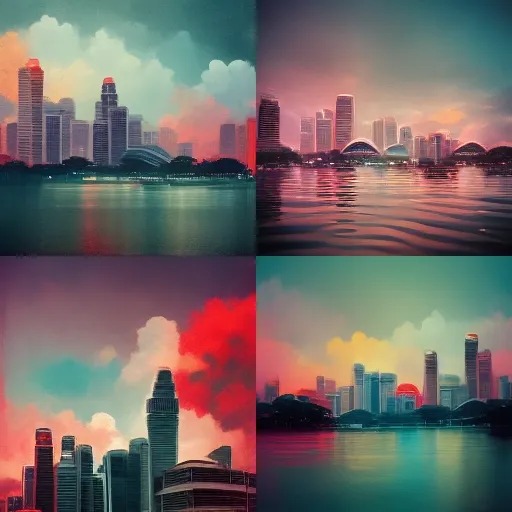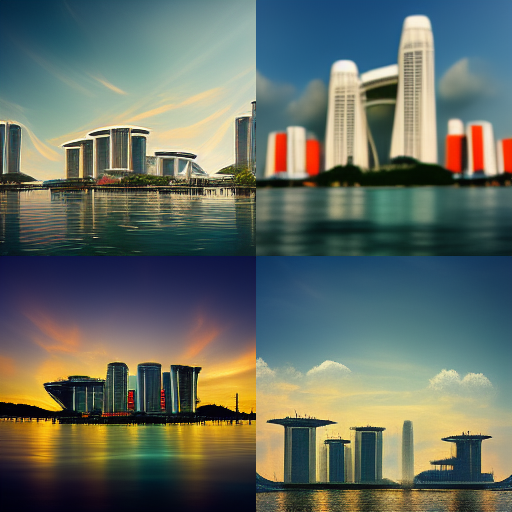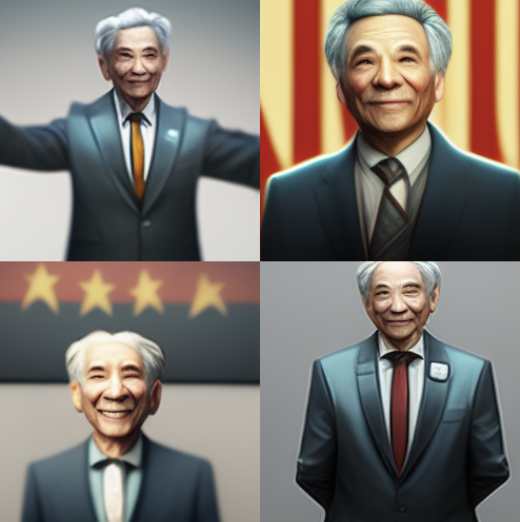THE PROCESS
IDEATION
We were interested to explore the text prompt brief but were unsure on what topic to settle on. None of us had used text-to-image generators before, so we decided to first familiarize ourselves with MidJourney. We started off by inputting random words into the software and one of the words that gave us interesting results were ‘Singapore Politics’ and ‘Singapore Education’.
The generated images were different from the
way Singapore is usually represented as a green city but still contained a degree of truth. For example, the
image generated with the ‘Singapore Politics’ prompt had a communist mood to it whereas the image
generated with the ‘Singapore Education’ prompt contained some truth in relation to the stress one faces
Singapore’s Education system. This discovery piqued our interest to uncover AI’s perception
of Singapore.


Singapore Politics 
Singapore Education 
Singapore Culture
INITIAL TESTING
The initial objective for this project was to observe how AI perceives Singapore in comparison to google search and subsequently, using keywords to refine/manipulate AI to represent Singapore in a more “idealistic” way.
Our previous approach:
1. Each member of the group will start by inputting words from their category into MidJourney
2. Input the same words into google search and compare how MidJourney results differ from it
3. From observing the images from google search, each member will start picking out keywords: according to the given guidelines - Colours, Graphic elements, Expression
4. Input the new keywords back into MidJourney, refining the search!
It was important to observe how the images progress from one step to another in the process. Hence, we
decided to use Figma’s FigJam to organise our images. This helped us to keep track of the text prompts
used along with the generated images and also, work
collaboratively as a team.

PARAMETERS
In order to keep the project focused, the team set up some parameters:
Narrowed to three aspects of Singapore: Landscape, Culture & Government
The project will end when the objectives are hit and when we run out of credits

OBSERVATIONS
As we were generating images with the approach, we realised how hard it was to refine and manipulate the images to match what we imagined. The more we tried to be specific in our text prompts, the stranger the images generated. We soon realised that our initial goal of representing Singapore in a more “idealistic” way was pre-determining the outcome and not allowing room for exploration. Being fixated on the outcome to turn out a particular way defeats the purpose of this project.


singapore, street art wall, mural, vibrant colors, alleyway 
singapore, chicken rice, wonton noodles, shaved ice with red beans, flat lay 
singapore religion, temple, cathedral, cross, islamic star, harmony
FINAL OUTCOMES
After re-evaluating the current state of our project, we made some refinements to our objectives and approach. Instead of representing Singapore in a more “idealistic” way, we decided to:
Observe how AI perceives information
To test AI’s ability to identify Singapore
Show biasness of tools and how they reinforce certain stereotypes

NAMING

Singapore, Marina Bay Sands, clear sky, three buildings with a cruise ship on top, waterfront 
singapore, hawker centre, crowded, tables and chairs in the background, people carrying trays of food, people sitting down to eat, vibrant colors, food 
singapore, prime minister, Lee Hsien Loong, waving hand, old man, proud, wearing suit
DESCRIBING

city, a complex that includes three towers connected by a cruise ship on the top, waterfront, social realism, 8k 
food centre, many stalls lined up with sign boards that are lit up, rows of tables and chairs, people sitting down to eat, people carrying trays of food, crowded, ceiling fans, unreal engine, 8k 
professional chinese old man in suit, prime minister, waving hand, old man, proud, wearing suit, flag behind him, smiling, asian, gray hair, behind podium, photorealistic, unreal engine, 8k
REVISED APPROACH
1. Each member of the group will start by inputting words from their category into MidJourney
2. Input the same words into google search and form a visual index using these categories as a guideline - Colours, Graphic elements and Expression
3. Input description back into MidJourney
4. Observe and compare the differences when using names and descriptions respectively


Singapore, Sentosa Island 
Colors: Green, Blue Graphic Elements: Theme Park, Aquarium, Cable Car, Sand, Beach, Island surrounded by water 
vibrant island with a theme park & aquarium, cable car, hotels & a casino, golf courses, plus sandy beaches, social realism, 8k
ARTEFACT
As we were dealing with a ton of images, our immediate response was to design a photobook to showcase the images. However, as our objectives changed, we thought about changing our artefact as well to something that elevate the images. We consulted a few lecturers and ended up deciding on a flag, where our images would be sorted by color forming a gradient.
The Flag: Singapore represented through a spectrum of colors. The artefact breaks away from the conventional way of using white and red to represent Singapore. The diversity of images represents the various ways to perceive Singapore. When viewed as a whole, one can catch glimpses of the different aspects of Singapore but closer inspection reveals the odd visuals that were produced.


